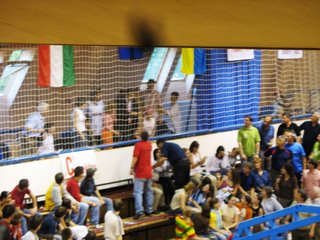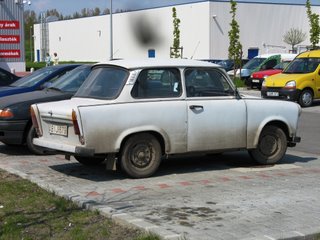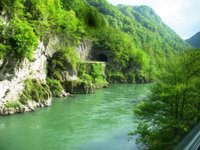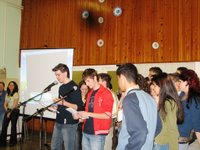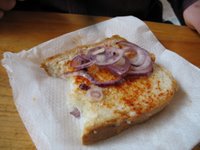Friday night I returned from a 24 hour visit to Kalocsa, a small city (18,000) in southern Hungary. I visited Harpswell (yes, that's her name. It's a small town in Maine). She's an American English teacher in the CETP program (same one that brought Chad and Emily to Hungary). I went there mainly to check out the community, the gimnazium (high school) and the elementary school. Cori and I are considering teaching there next year.

Returning to Szolnok, I hurried to Jazz Club, for the Oxford Language School English party. I had agreed to work the party (sit and mingle with the English students). The night was fun. We played trivia games, impersonated celebrities, sang karaoke. Of course, since is was in a bar, as the night wore on, people loosened up more and more.
Saturday I relaxed in my flat, before heading to Budapest Sunday. Actually, I wanted to go to Tápiógyörgye for an archery festival, but as I walked to the train station in the morning, the rain started to fall, washing away any intentions I had to walk around a remote field dodging 11th century arrows. So, instead I was off to the magical Hungarian land of concrete.
It's nice sometimes just to get out of Szolnok, away from my flat, my teaching responsibilities, and all who know me, and get lost amid 3 million Hungarians and a couple ten thousand tourists.
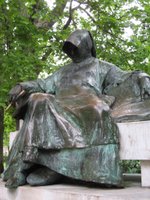
("Anonymous," a statue in Budapest's City Park honoring the unknown monk who, during the 11th Century, penned the first history of the Hungarian people. It is said that if you touch the writer's pen you'll have good luck. Unfortunately, I found this out after I visited.)
I spent much of Sunday afternoon sitting under an umbrella on a cafe patio sipping coffee and reading The Eclipse of the Crescent Moon.
Later, I walked along Andrassy Utca, past Oktogon Tere, to Hosok Tere, or Hero's Square. The momument memorializes the great Hungarian kings, beginning with Arpad, and continuing through Stephen (St. Istvan), Bela IV, Matthias Corvinus, and Rakoczi, among others. Beyond this is City Park. This day the park was home to a festival, perhaps Native American. Oddly, however, among all the dream catchers, pan flutes and fry bread, an Irish band played the main stage. What a strange cultural salad bowl I was in: lost in a sea of Hungarian speakers listening to a man with a heavy Irish brogue sing in English and then speak broken Hungarian between
 songs while Native Americans and Native Canadians peddled "traditional" wares to the curious locals. Aah, the benefits of a free market economy.
songs while Native Americans and Native Canadians peddled "traditional" wares to the curious locals. Aah, the benefits of a free market economy.(Vajdahunyad Vara, a 19th Century, non-functional castle located in Budapest's City Park. It was built to demonstrate - likely to tourists - the various architectures present throughout Hungary)
 Monday I got up early (after a night at the $12 ABB Youth Hostel), showered, and was (apparently) the first one out of the hostel. It's sort of a small victory for me to be the first one up at a hostel...no fussing with a wet bathroom, no waiting for the shower, etc. I headed off to find some kave and pogacsa and "have a morning."
Monday I got up early (after a night at the $12 ABB Youth Hostel), showered, and was (apparently) the first one out of the hostel. It's sort of a small victory for me to be the first one up at a hostel...no fussing with a wet bathroom, no waiting for the shower, etc. I headed off to find some kave and pogacsa and "have a morning."First stop: St. Istvan Basilika. In front of the city's largest church I sat and read my travel guide book while drinking amerkai kave (basically a double shot of espresso) and eating saytos pogacsa (cheese pastry).
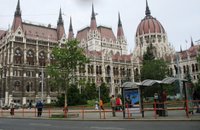
After an hour waking up, I went to the House of Parliament for the 10 AM tour. It's a fairly difficult bureauratic process to get on the tour. First you have to line up outside a fence gate, about 30 yards from a door marked "X." Inside that door, people are buying tickets. Everytime a tourist exits the door, the security guard opens the fence gate and lets another person or two in. Once inside door "X" I had to wait in another line for the tickets (I've learned many times that Hungarian people are some of the best at waiting...a trip to an American DMV is no sweat for these hardy folk). In line, I could hear other American tourists being told that the 10AM English tour was full, and they were being booked for the noon tour. Disappointed but not rebuffed, I figured I would ask for the 3PM tour, allowing me to see other sights in the meantime.
I don't know if it was my feeble attempt at Hungarian kindness, or my dashing looks, but the once cold, obviously former communist era ticket seller, softened.

"Csokolom. Jo napot kivanok" I mumbled (CHO-kuh-loam: literally "I kiss your hand." YO nuh-pot KEE-vuh-no: "good day"). Both very formal and standard things to say to an older woman.
I asked for one ticket and she asked if I was a student. I produced my Concordia University card, and viola, I the ticket price plummeted from 2500 huf to 1250! She then handed me my ticket for the 10AM tour!

I wanted to wave it around in the faces of the disappointed American tourists who didn't come prepared with the Hungarian greeting (or the dashing looks)! But, the hunble gentleman that I am, I ambled back outside, back into another line, to wait for the tour.

(Afterward, I strolled along the bank of the Duna (Danube) walking past a stirring memorial to "the victims shot into the Danube by Arrow Cross Militiamen in 1944-45")
Lunch was at Fat Mo's Speakeasy. Home to nightly jazz, blues and small band swing. Good stuff from what I read. I'll make an effort to return in June with Cori and my dad. Another good sign: when I sat at the table, the paper placemat features four American newspaper front pages from the prohibition era. Two of them were The Wisconsin News (an early 20th Century Milwaukee newspaper owned by famous media magnate William Randolph Hurst...later it would become the Milwaukee Sentinel, which in the mid-1990's merged with the Milwaukee Journal to form the Journal-Sentinel)

I spent the rest of the day exploring Buda, the older of the two cities (Pest being the other) and Gellért Hill, named for the Catholic bishop who was martyred there in the 11th century. As the story goes, he was put inside a barrel, then nails were driven in, and the barrel was tossed down the rocky escarpment. At the bottom and inspection of Gellért's battered body revealed he had miraculously survived the trauma. So, like any good pagan, they drove a spear into his chest then stoned him.

(I did manage to slay a dragon during the afternoon, but hey, it's all in a day's work.)

On Gellért Hill one finds the Gellért Hotel, featuring the best known of the generally famous Hungarian thermal baths. The city is filled with them. Also on the hill is the Cave Church. Completed in 1924, the church was operated until WWII. Following the war the Soviets kept it closed down, and infact damaged a large portion of while road building. The monks built a concrete wall to close off the church, thus preserving it until today. It was reopened less than 20 years ago.
I took a swift train back to Szolnok (1h 30m compared to the grueling 2:45 train I took to BP Sunday). When I did something in Szolnok I hasn't done since being here: I ate Mcdonald's (about 6 weeks ago I had Mickey-D's while in Budapest - you might remember I found out they charge for ketchup). And was it ever good.
I'm lovin' it.



